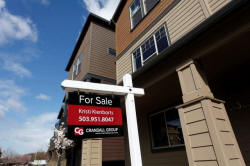|
The chase heats up for
the best refinancing rates
 Send a link to a friend
Send a link to a friend
 [July 12, 2016]
By Beth Pinsker [July 12, 2016]
By Beth Pinsker
NEW YORK(Reuters) - After thrice
refinancing the house she had bought in 2012, Nedalee Thomas thought
she was done.
Then, she heard that 15-year mortgages were suddenly down to 2.75
percent, better than the 3.125 rate she had locked down this past
fall.
"I might make a phone call right now," said the 54-year-old
businesswoman from Orange County, California, who also runs a
website for teaching personal finance (http://www.princesspower.com/main/).
Thomas is among a new rush of homeowners reconsidering what they
assumed were rock-bottom mortgage rates.
But then Britain voted to leave the European Union June 23, and
roiling financial markets upended the prevailing wisdom that
interest rates were on the way back up, and the window for
refinancing had closed.
"I thought we'd be firmly at 4.5 percent and trending higher, but
we're likely going to see the numbers under 3.4 percent," said
Jonathan Smoke, chief economist for Realtor.com.
More than 60 percent of mortgages are under 4.5 percent already,
according to Molly Boesel, principal economist for CoreLogic.
There not been much movement to refinance among those with higher
rates over the past several years of historically low rates, she
noted.

But there are a significant number of mortgages in the 4.0 to 4.5
percent range, which is what is now in play. These are the people
who drove up refinancing applications tracked by the Mortgage
Bankers Association by 20 percent in the wake of Britain's vote,
Smoke said.
HAPPY NEWS
The timing is good for homeowners who may be able to capitalize on
low rates and rising home values.
Edwin Ivanauskas, a 30-year-old marketing executive based in Salt
Lake City, Utah, bought a house in 2012 with a 30-year mortgage at
4.125 percent. Ivanauskas was happy with his rate, but not with
paying $212 a month in private mortgage insurance because he only
put 10 percent down.
When Ivanauskas saw the Brexit news, he called the bank that issued
his mortgage. He is now in the process of refinancing to a 20-year
mortgage at 3.5 percent, with no private mortgage insurance (PMI).
He is saving about $45 a month and more than $100,000 by cutting
those 10 years off the loan.
"What goes toward the principal is $200 more a month," said
Ivanauskas.
While most experts say a full percentage point or a half point is
the right guide, even a quarter point difference might be worth it
for homeowners who are going to stay put for a while, said Keith
Gumbinger, vice president of mortgage resource HSH.com (http://hsh.com).
Gumbinger suggested that homeowners nearing retirement might even
want an adjustable-rate mortgage, which are usually risky in an
environment where rates are likely to rise.
He gives the example of a 58-year-old who plans to retire at 65 and
move to Florida: A 7/1 adjustable-rate mortgage (ARM) with a rate of
3 percent or lower could be a cost-savings, if the homeowner sells
before the rate adjusts.
[to top of second column] |

Homes are seen for sale in the southwest area of Portland, Oregon
March 20, 2014. REUTERS/Steve Dipaola

HOW LOW CAN YOU GO?
For homeowners chasing rates, how low is low enough?
"If you're below 4 percent, you still have the best of the last 50
years. It will be hard to improve on that," said Gumbinger.
Gumbinger said those who feel like they should be capturing every
rate drop should be aware that there are costs associated with
refinancing, even if marketed as "no-cost."
Most people do not consider that extending the length of the loan
even by a couple of years can add on thousands in interest costs,
and rolling closing costs into the loan adds to the bottom line.
On the other hand, if homeowners are responsible with the monthly
savings they gain with a refinance, it can become part of their
retirement plans.
Gerald Freisleben, 50, and his wife are serial refinancers with a
purpose - to pay down as much principal as possible on their home in
Encino, California. They started with a refinance in 2013, taking a
5.25 percent rate down to 4.75. Then came four more refinancings.
Freisleben said they saved about $100 a month at every interval. The
latest, still in progress, will take them down to 3.5 percent, just
3/8 of a point below a refinance they just completed five months
ago.
"Itís forced discipline. With the additional principal payments,
weíll be amortizing our new 30-year loan over about 22 years
instead," said Freiselben, who owns a corporate communications firm.
And with that, he thinks they are done. Well, maybe.


"This is unprecedented in my lifetime, so itís all a function of
what happens," Freiselben said.
(Editing by Lauren Young and Bernadette Baum)
[© 2016 Thomson Reuters. All rights
reserved.] Copyright 2016 Reuters. All rights reserved. This material may not be published,
broadcast, rewritten or redistributed. |